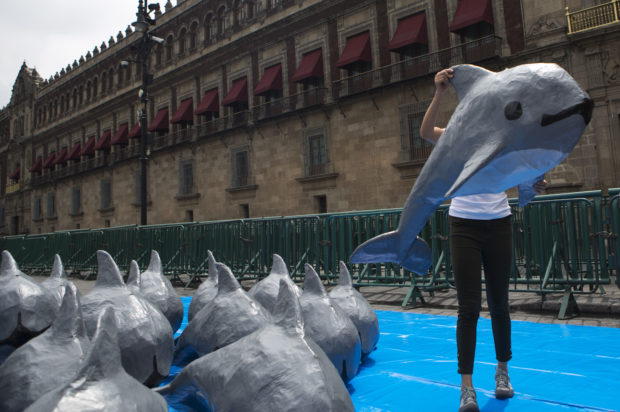Efforts to save Mexico’s endangered porpoise end

In this July 8, 2017 file photo, a young woman with the World Wildlife Fund carries a papier mache replica of the critically endangered porpoise known as the vaquita marina, during an event in front of the National Palace in Mexico City. Researchers in Mexico were thrilled to have captured one of the few remaining vaquita porpoises on Saturday, Nov. 4, but the adult female died after a few hours in captivity in a floating pen, raising questions about the last-ditch effort to enclose the world’s smallest porpoises to save them from extinction. (AP Photo/Rebecca Blackwell, File)
MEXICO CITY — Experts have suspended a program to conserve the few remaining vaquita porpoises in Mexico’s Gulf of California, after the one they managed to catch died quickly in captivity.
Lorenzo Rojas, the lead scientist in the effort, described on Wednesday what might be the last close contact between humans and the world’s smallest porpoise, of which less than 30 remain. Rojas said he doubts there will be enough of the elusive porpoises left by 2018 to even make an attempt to capture any.
“She was adapting, but in a few seconds something triggered in her brain and she just started swimming faster, incredibly fast, like she wanted to fly away from where it was, with no perception of the space, inside where she was,” Rojas said of the adult female captured over the weekend.
That vaquita had been taken to a floating pen on the sea where experts had hoped to protect her, but the animal began to act oddly in obvious stress. The only other vaquita captured – a calf – had also quickly shown signs of distress and was quickly released weeks ago.
The experts tried to do the same with the adult female, but it was too late.
“The vets decided it was time to release her. They pulled her out to sea and they put the animal facing the open ocean, and it started swimming, but it started swimming in a very random way … and the vets decided to bring her up on the boat again,” said Rojas, chairman of the International Committee for the Recovery of the Vaquita. “They did CPR for three hours and tried to keep it alive.”
The vaquita died about six hours after capture. An autopsy and test are being conducted to determine why it died.
But with so few vaquitas left, the ones remaining could not be put at risk, experts said.
“These tiny porpoises do not respond well to the stress of capture, and not a single additional vaquita should be deliberately put in danger in this way,” the Animal Welfare Institute said.
Chillingly, initial results from the autopsy of the dead vaquita showed that she had not had a calf in two or three years. There may be so few left they are having difficulty finding breeding partners.
Mexico’s environment minister, Rafael Pacchiano, tried to put the best face on things, saying the search effort had at least found vaquitas.
“We have seen several groups of vaquitas, including mothers with calves, so that is a good sign,” Pacchiano tweeted. “Conservation of the vaquita will continue being a priority.”
But Rojas said that despite sea patrols by Mexico’s navy and a crackdown on illegal gillnet use; illegal fishing appears to be continuing.
The vaquita has been driven to the brink of extinction by China’s appetite for the dried swim bladder of the totoaba, a fish that also lives in the Gulf of California, which is also known as the Sea of Cortez.
Authorities believe the bladders may now be worth thousands of dollars each on the black market.
Illegal gillnets set for totoaba catch and kill vaquitas, and as the price of the dried bladders has risen, illegal fisherman have used more expensive equipment and more reckless tactics to set their nets.
Rojas said his team had expected to clean up only old nets left over from before Mexico imposed a gillnet ban in the vaquita’s habitat. But they were surprised to find brand new nets that “had been placed in the water probably a day or two before we got there.”
Video footage of enforcement patrols seen by The Associated Press show illegal fishermen leading patrol boats on long chases using go-fast boats, refusing to stop when ordered and driving up on boat trailers pulled into surf by pickup trucks to make their escape. /kga